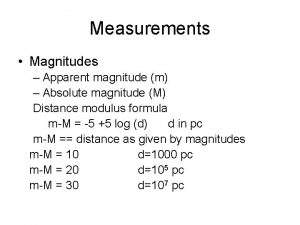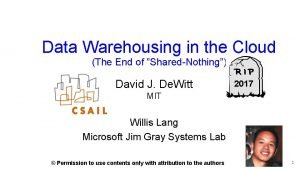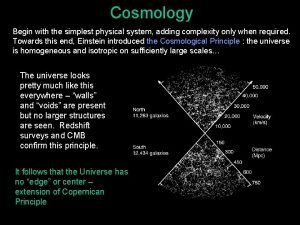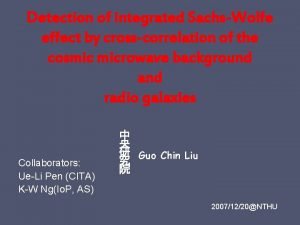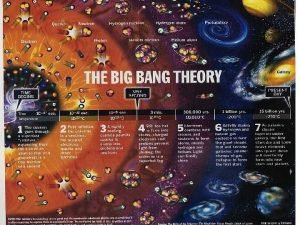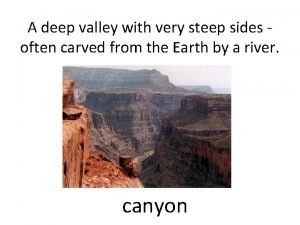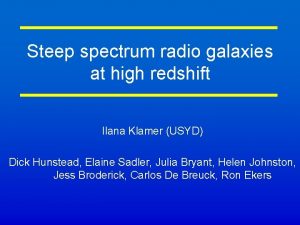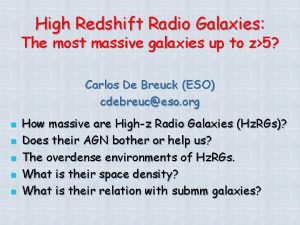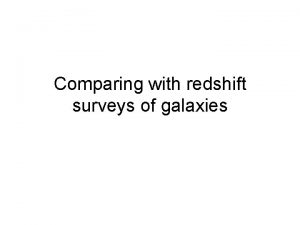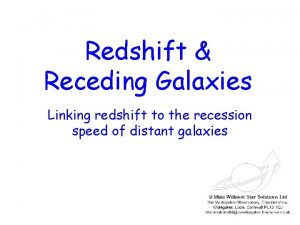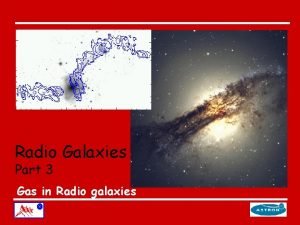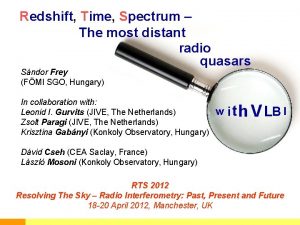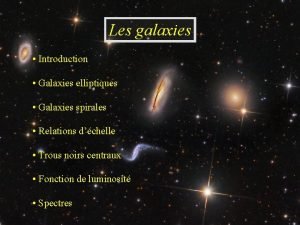Steep spectrum radio galaxies at high redshift Ilana











- Slides: 11

Steep spectrum radio galaxies at high redshift Ilana Klamer (USYD) Dick Hunstead, Elaine Sadler, Julia Bryant, Helen Johnston, Jess Broderick, Carlos De Breuck, Ron Ekers

How to find a Hz. RG steep flat • A trend/correlation exists between the redshift of a radio galaxy and its radio spectral index measured in the observed frame. • Spectral index culling of existing radio sky surveys preferentially selects Hz. RGs. e. g. Rottgering et al 1994, Blundell et al 1998, De Breuck et al 2000, 2004

Using SUMSS & NVSS to search for Hz. RGs • USS selection: SUMSS (843 MHz) & NVSS (1400 MHz) • S(1400)>15 m. Jy & a <-1. 3 • -30<d<-40 • Parent sample 76 sources – (De Breuck et al. 2004) • 35 spectroscopic redshifts so far including 5 with z>3 – (De Breuck et al. 2005, in press)

Conventional wisdom for the correlation: 1 z=5 S A X E T S S NV Negative k-correction of concave radio spectrum

The k-correction is a good explanation because: • Less significant correlation between z & arest – e. g. Carilli et al 1999, Blundell et al. 1999, Lacy et al 1993, Gopal. Krishna et al 1989 • But, a correlation still exists. . . – e. g. Carilli et al 1999, Blundell et al. 1999, Lacy et al 1993

ATCA observations of the SUMSSNVSS USS radio galaxies Matched low resolution ATCA observations at 2. 4 GHz (12. 5 cm), 4. 8 GHz (6. 3 cm), 6. 2 GHz (4. 8 cm) Further ATCA observations at 8. 6 GHz (3. 5 cm) & 18 GHz (1. 7 cm) for z<2 objects in sample Constructed rest frame SEDs (using K-z relation to estimate z when necessary)

but USS spectra don’t steepen at all… • our ATCA observations confirm that high-z radio galaxy spectra are not curved The k-correction interpretation is inconsistent with observations

• • The number of nearby USS radio galaxies in 5 GHz selected surveys is <1%. So USS Hz. RGs are still extreme in some way. They do not represent a ‘typical’ radio galaxy in energy loss regime Kuehr et al. 1981 Stickel et al. 1994

• It is well known that local USS sources are rich cluster sources (e. g. Slee et al 1983) • This is interpreted as pressure confinement of the radio lobes which keeps the oldest (steepest) radio emission above a given surface brightness • Nearby USS sources are very RARE, but majority reside in regions of unusually high ambient gas density • This explains the z-a correlation: there is simply more gas at high redshift Murgia et al. 2005 Learning from the neighbours…

The Gaseous Environments of Distant Radio Galaxies • Linear Sizes • Cosmological expansion • Gas and Dust Reservoirs – Stevens et al 2003, Kurk et al 2004 • Rotation Measures – 1000 -18350 rad m 2 -> X-ray cluster scale densities (Carilli et al. 1997, Pentericci 2000, Athreya 1998, Benn 2005) • Clustering Environments – e. g. Kurk et al. 2000, Venemans et al. 2002, 2004 Miley et al. 2004 • Proto-cluster Masses – ~2 -9 x 1014 Msun -> rich clusters (Venemans et al. thesis) • Knotty “frustrated” Jets – dense & clumpy IGM on scales of 85 kpc (Carilli et al. 1997)

SUMMARY • The z-a correlation is exploited to find high-z radio galaxies by data mining radio all sky surveys • We have selected 76 USS sources selected from the SUMSS and NVSS • So far we have discovered 4 new radio galaxies at z>3 • The USS galaxies DO NOT have concave SEDs • The nearby USS galaxies reside in dense gaseous environments • Observations show similar environments around high-z radio galaxies • The z-a correlation now has a plausible physical explanation

